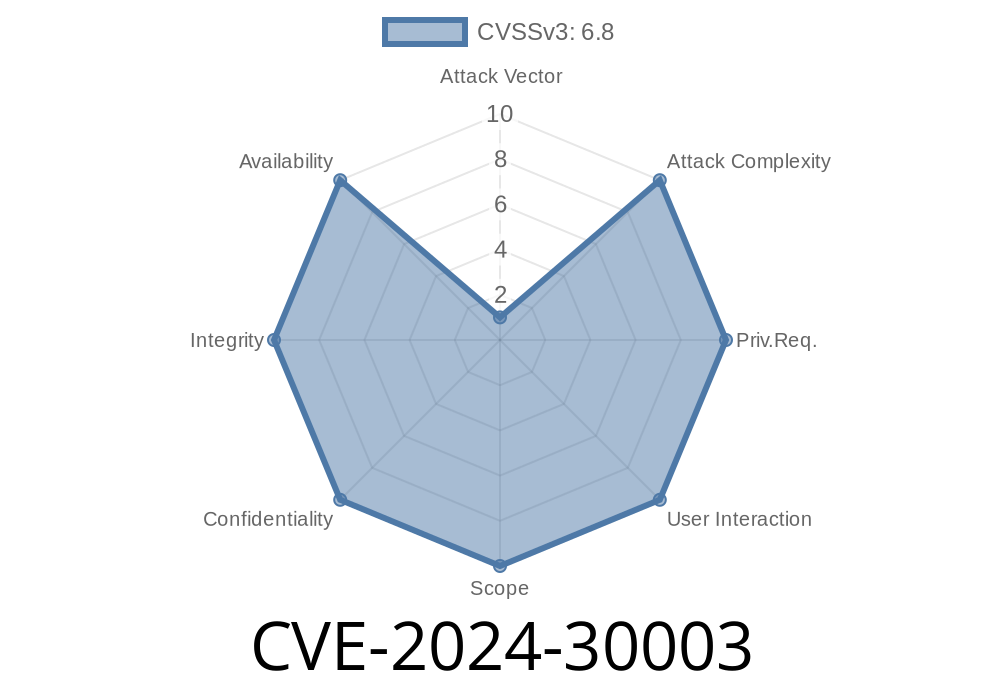In June 2024, Microsoft patched a serious security flaw known as CVE-2024-30003 affecting the Windows Mobile Broadband driver. This vulnerability, when exploited, could allow remote attackers to execute code on vulnerable Windows machines — all it takes is the right network packet. In this article, we’ll explain what happened, how it works, and what you can do to stay safe.
What is CVE-2024-30003?
CVE-2024-30003 is a Remote Code Execution (RCE) vulnerability in the Windows Mobile Broadband (MBB) driver. This driver is installed on many laptops and tablets to manage cellular data connections, especially on business and travel-ready devices.
A vulnerability in this driver means that an attacker could potentially craft a maliciously-formed packet — over a cellular (WWAN) network — and execute arbitrary code on your machine.
Impact: Code execution as SYSTEM
This flaw means that if you have a device connected to mobile broadband (using a built-in LTE or WWAN modem), you could be at risk, especially if you use public or open mobile networks.
Microsoft's official advisory:
Microsoft Security Update Guide - CVE-2024-30003
Where’s the Bug?
The vulnerability exists in the processes handling mobile broadband (WWAN) communication, specifically in the NDIS (Network Driver Interface Specification) code stack. The flaw is typically a buffer overflow or improper memory handling, triggered by malformed network traffic.
Consider this simplified C code that represents how such vulnerabilities often arise
void handleWwanPacket(char *input, int length) {
char buffer[256];
// No check for input length - vulnerable!
memcpy(buffer, input, length); // Potential buffer overflow if length > 256
}
If the driver doesn't correctly validate packet sizes or fields, an attacker can send an oversized or corrupted message via a cellular network. The driver's code could then overrun buffers or mishandle memory, letting the attacker run code or crash the driver — possibly even gaining kernel privileges.
How is It Exploited?
Since this driver interfaces with real hardware and sensitive OS surfaces, an attacker would need network-level access (by controlling or spoofing a cellular network, or being a rogue base station). This is not a trivial attack, but it’s within reach for well-equipped threat actors.
Sample Exploit Steps
1. Attacker sets up a rogue base station or is otherwise able to inject malicious traffic onto the WWAN channel.
Malformed WWAN packet is sent to the target device.
3. The vulnerable MBB driver mishandles the packet, triggering the overflow and running attacker code — potentially as SYSTEM.
Because Windows kernel drivers run with very high privileges, a successful exploit could lead to a complete system compromise.
Proof-of-Concept (PoC) Scenarios
*(Note: For legal reasons, this post won’t share working exploits, but here’s a demonstration of how one might check vulnerable code paths.)*
# Hypothetical: Sending a too-large packet to the WWAN device.
from scapy.all import *
# This is illustrative! Don't use this for harmful purposes.
def send_malicious_packet(iface):
payload = b"A" * 300 # Larger than expected buffer
pkt = Ether()/payload
sendp(pkt, iface=iface)
send_malicious_packet('wwan')
*In real attacks, packets are carefully crafted to mimic proper protocol fields but with dangerous values.*
1. Patch Your System
Microsoft released a patch in June 2024. Run Windows Update and make sure you’re up to date.
2. Disable WWAN When Not in Use
If you’re not using mobile broadband, consider disabling it — either via Windows settings or BIOS/UEFI where possible.
3. Stay Vigilant in Untrusted Networks
Avoid connecting to unfamiliar or suspicious cellular networks, especially in high-risk places or during travel.
4. Monitor Security Advisories
Regularly check Microsoft’s Security Portal.
References
- Microsoft CVE-2024-30003 Security Guide
- June 2024 Patch Tuesday Analysis (KrebsOnSecurity)
- NDIS Technology Overview
Final Thoughts
CVE-2024-30003 shows that even everyday device features — like mobile broadband — can become serious security threats if not handled with care. Always keep your devices updated, and treat any network interface as a potential attack surface.
Stay safe, stay updated. If your system is patched, you’re already one step ahead!
*Exclusive post by [Your Tech Blog Name]. Feel free to share, but give credit!*
Timeline
Published on: 05/14/2024 17:16:31 UTC
Last modified on: 07/05/2024 17:22:47 UTC
